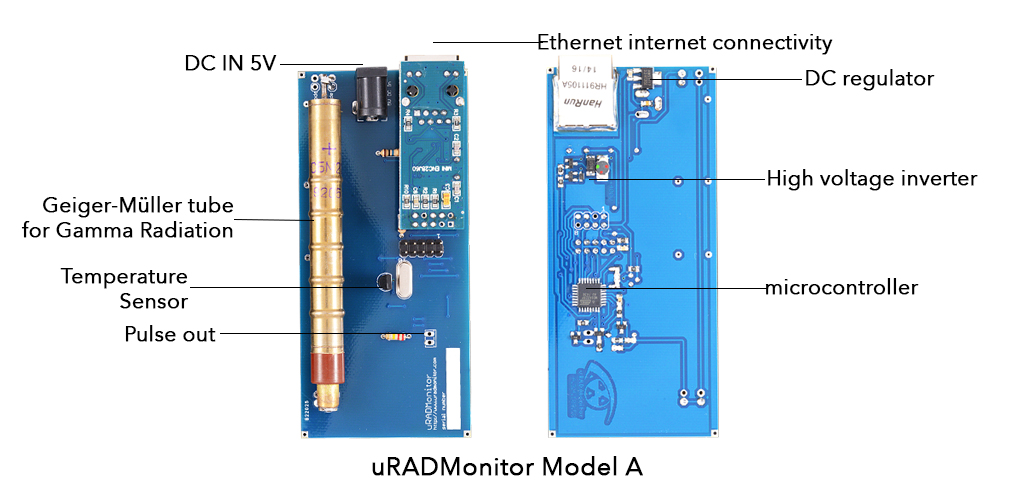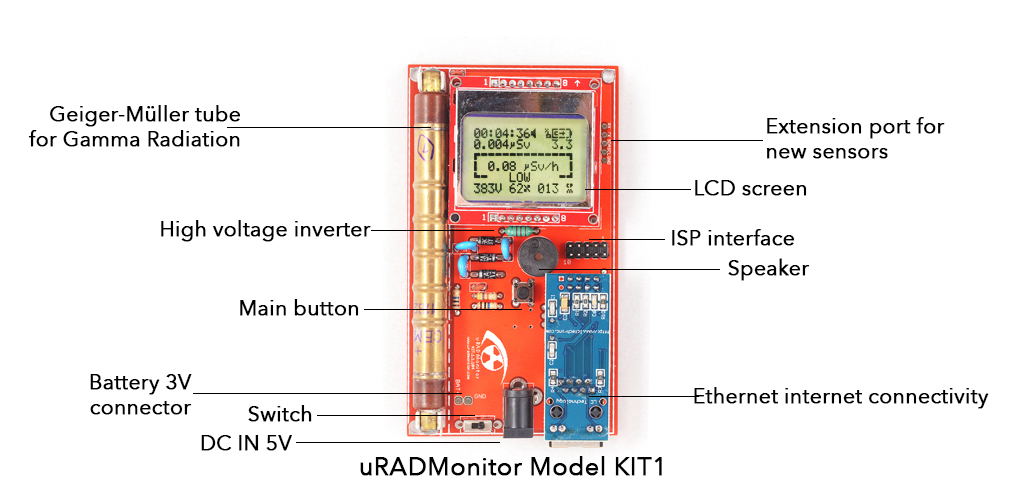MODEL AContact us
A high quality, automated radiation dosimeter, in a rugged rainproof aluminium enclosure. It runs on little power and doesn't need a computer. Measurements are transmitted automatically to the Internet using an Ethernet connection to your internet Router. They can be accessed on the uRADMonitor portal or in your local network, directly.
Urs, Switzerland: "My second A3 has just been delivered - perfect service!"
uRADMonitor model A uses the military grade SBM20 Geiger Tube to detect gamma and x-ray ionising radiation. It also features a digital temperature sensor.
* Each Model A dosimeter is subjected to a final test: the tested device must be in a confidence interval of 5% in comparison to a master. This master is adjusted to a gauged reference Cs-137 emitter.
| Sensor | Parameter | Minimum value | Maximum value |
| Dallas DS18B20 | Temperature | -55 °C | +125 °C |
| SBM20 * | γ,x-rays | 0.01μSv/h | 9999.99μSv/h |
The purpose of the Model A is to generate a global image on the radioactive background level, ranging from natural sources such as soils rich in radioactive elements to man made sources mostly released in case of nuclear incidents, illegal nuclear activities or illegal transportation of nuclear materials. Being spread across the entire planet, the network of Model A detectors provides early warning and action can be taken to limit further damage.
Ionizing radiation is harmful to living organisms because it can cause damage to cells that can result in multiple disorders , the most common of which is cancer. Ionizing radiation is naturally occurring from cosmic and terrestrial sources, but there are also artificial generators related to nuclear activities or x-ray devices . Worldwide global average dose is 3.01mSv [1].
[1] Radiation Health Effects, US Environmental Protection Agency
[1] Radiation Health Effects, US Environmental Protection Agency
The model A is designed as a fixed monitoring station. Monitoring radiation brings certain advantages over simply using a handheld unit occasionally. First it's the capability of identifying the radiation trend, due to long term measurements, and taking action in regards to the evolution of numbers rather than not knowing how to interpret short time readings. Then with long term continuous monitoring we get a clue even on low level changes that often evade portable localized readings (unless the levels are higher). Finally having an automated system monitoring radiation 24/7 results in keeping you informed all the time, not only on occasional situations like when using a handheld for an isolated check. The data can be viewed remotely on a computer or on a mobile device. You can also access the unit in your LAN directly, by opening its DHCP assigned IP in your Internet browser.


| Item | Parameter | Ratings |
| Voltage | External | 5V - 9V |
| Connectivity | Ethernet | |
| Microcontroller | Atmega328p | 8 bit |
| Enclosure | Rugged aluminium | 110x80x24 mm |
| Temperature | Operating Range | -20°C to +65°C |
Your uRADMonitor should be mounted outside, but not directly exposed to sun, to avoid overheating in warmer areas. A covered spot with some shadow in the free air is ideal. The unit has a rugged aluminium enclosure that is rainproof when mounted with the cables down. The enclosure has wall-mounting brackets, making installation easy. A distance of 1 meter (3 feet) above the ground level is recommended for more relevant measurements.
Connect the uRADMonitor to the power source using the DC cable and the power adapter, and to the Internet router using the Ethernet cable. Use a longer cable if needed. The Internet router must have DHCP enabled. When powered, the uRADMonitor gets an IP automatically, via DHCP, and will show up on the map. It uses very little energy to run!
MODEL KIT1Contact us
Intended as open source for those who want to build their own dosimeter with their own tools, this is also available pre-assembled. It measures Gamma radiation and with the integrated Ethernet connectivity will send all measurements automatically via the Internet. Add a battery and it can also be used as a portable dosimeter, showing all measurements on the LCD.
Trance, USA: "It indeed seems like an extremely comprehensive and sturdy device."
uRADMonitor model KIT1 uses the military grade SBM20 Geiger Tube to detect hard beta, gamma and x-ray ionising radiation.
| Sensor | Parameter | Minimum value | Maximum value |
| SBM20 | γ,x-rays | 0.01μSv/h | 9999.99μSv/h |
| Hackable | Add any additional sensors |
The KIT1 improves global image on the radioactive contamination, ranging from natural sources such as soils rich in radioactive elements to man made sources mostly released in case of nuclear incidents, illegal nuclear activities or illegal transportation of nuclear materials. Being spread across the entire planet, the network of uRADMonitor detectors provides early warning and action can be taken to limit further damage. As an open source design it can be hacked and modded to add more sensors in a convenient way, using a proven robust platform.
Ionizing radiation is harmful to living organisms because it can cause damage to cells that can result in multiple disorders , the most common of which is cancer. Ionizing radiation is naturally occurring from cosmic and terrestrial sources, but there are also artificial generators related to nuclear activities or x-ray devices . Worldwide global average dose is 3.01mSv [1].
[1] Radiation Health Effects, US Environmental Protection Agency
[1] Radiation Health Effects, US Environmental Protection Agency
The KIT1 can be used both as a mobile detector and as a fixed monitoring station. It is released as Open Source, with complete specs publicly available. You can purchase it as an assembled unit, usable out of the box, or as a solderable kit, and then you'll need to assemble it first. This is a versatile product: you can use it as a fixed monitoring station, then simply hook up a battery and take it with you as a mobile dosimeter.
The data can be viewed on the LCD or remotely on a computer or on a mobile device. You can also access the unit in your LAN directly, by opening its DHCP assigned IP in your Internet browser.


| Item | Parameter | Ratings |
| Voltage | External | 5V - 9V |
| Battery | 3V (2xAA) | |
| Connectivity | Ethernet | |
| Microcontroller | Atmega328 | 8 bit |
| Size | 110x60x12 mm |
If you intend to use the KIT1 as a monitoring station, find a protective enclosure that is rainproof and a covered spot with some shadow in the free air. A distance of 1 meter (3 feet) above the ground level is recommended for more relevant measurements. Connect the uRADMonitor to the power source using the DC cable and the power adapter, and to the Internet router using the Ethernet cable. Use a longer cable if needed. The Internet router must have DHCP enabled. When powered, the uRADMonitor gets an IP automatically, via DHCP, and will show up on the map. The LCD will dim after a certain time, to conserve power.
MODEL DContact us
This is a compact portable environmental dosimeter, capable of measuring Alpha, Beta and Gamma radiation but also air quality as PM2.5 and Volatile organic compounds. It is a modern design, featuring a large colour LCD screen with touchscreen, a GPS receiver to tag all measurements and a SDCard slot. It comes with WLAN connectivity to send all data online.
Chris, Australia: "Thanks guys, great project."
uRADMonitor model D uses the BME680 from Bosch to measure air temperature, barometric pressure, humidity and volatile organic compounds, or VOC. A Sharp photoelectric sensor is used to detect the Particulate Matter PM2.5 concentration in air. A high quality LND712 Geiger Tube Made in the USA allows this dosimeter to detect alpha, beta, gamma and x-ray ionising radiation.
* Each Model D dosimeter is subjected to a final test: the tested device must be in a confidence interval of 5% in comparison to a master. This master is adjusted to a gauged reference Cs-137 emitter.
| Sensor | Parameter | Minimum value | Maximum value |
| Bosch BME680 | Temperature | -40 °C | +85 °C |
| Pressure | 300 hPa | 1100 hPa | |
| Humidity | 0% RH | 100% RH | |
| VOC | 0 mg/m³ | 100 mg/m³ reducers 10 mg/m³ oxidizers | |
| Sharp GP2Y1010AU0F | PM2.5 | 0 μg/m³ | 800 μg/m³ |
| LND LND712 * | α,β,γ,x-rays | 0.005μSv/h | 5000.00μSv/h |
The purpose of the model D detector and that of the entire uRADMonitor network is to monitor chemical and physical factors that can have a negative impact on our health or on the environment. Using its advanced sensors, the model D monitors against the following potentially hazardous parameters:

Picture: Air pollution can shorten our lifespan, this is why we need uRADMonitor
VOC or volatile organic compounds, are a class of substances that evaporate at room temperature. Being different substances, may be responsible for a broad category of disorders, including respiratory problems, allergic or weakening immunity in children. Some VOC 's are responsible for the formation of smog, irritation of eyes, nose and throat, headaches and concentration problems. In extreme circumstances, more severe complications can occur, such as damage to liver, kidney and central nervous system or cancer [1].
Ionizing radiation is harmful to living organisms because it can cause damage to cells that can result in multiple disorders , the most common of which is cancer. Ionizing radiation is naturally occurring from cosmic and terrestrial sources, but there are also artificial generators related to nuclear activities or x-ray devices . Worldwide global average dose is 3.01mSv [2].
Particulate matter PM2.5 refers to small particles with a diameter of up to 2.5 microns. These particles can penetrate deep into the lungs , causing allergies, respiratory and cardiovascular diseases [3].
[1] Volatile Organic Compounds' Impact on Indoor Air Quality, US Environmental Protection Agency
[2] Radiation Health Effects, US Environmental Protection Agency
[3] Health and Environmental Effects of Particulate Matter (PM), US Environmental Protection Agency

Ionizing radiation is harmful to living organisms because it can cause damage to cells that can result in multiple disorders , the most common of which is cancer. Ionizing radiation is naturally occurring from cosmic and terrestrial sources, but there are also artificial generators related to nuclear activities or x-ray devices . Worldwide global average dose is 3.01mSv [2].
Particulate matter PM2.5 refers to small particles with a diameter of up to 2.5 microns. These particles can penetrate deep into the lungs , causing allergies, respiratory and cardiovascular diseases [3].
[1] Volatile Organic Compounds' Impact on Indoor Air Quality, US Environmental Protection Agency
[2] Radiation Health Effects, US Environmental Protection Agency
[3] Health and Environmental Effects of Particulate Matter (PM), US Environmental Protection Agency
These are mobile units powered by a high capacity Lithium Ion rechargeable battery, with a GPS receiver for location mapping and Wifi connectivity, but also with a SDCard slot to store all readings when WLAN is not available. This not only addresses radioactivity in a similar way to existing top-notch dosimeters, but it also measures the air pollution, contributing with valuable data to the uRADMonitor network. The model D also features an Alarm built in and has a touchscreen to provide visual and audible indications, keeping you informed all the time. Using the uRADMonitor backend infrastructure and model D's wireless data sharing capabilities, the global readings provide useful data on pollution, its geographical distribution, and evolution in time.

Picture: Complex uRADMonitor motherboard front and bottom view

| Module | Parameter | Ratings |
| Battery | Lithium Ion | 1500mAh |
| GPS | Channels | 50 |
| First fix | 27s / 1s | |
| Accuracy | 2m | |
| LCD | Size | 2.4" |
| Touchscreen | resistive | - |
| Wifi | Protocols | 802.11b/g/n |
| SDCard | Type | MicroSD SDHC |
| Microcontroller | Atmega2561 | 8 bit |
| Real Time Clock | GPS synced | - |
| Enclosure | Rugged aluminium | 110x70x24 mm |
While intended exclusively as a portable dosimeter, there's nothing against using the model D as a fixed monitoring station. You will only need to keep the power cable inserted and make sure the WLAN is connected. If left outdoors, make sure the unit is protected from the elements. The LCD dims after a certain amount of time to conserve power.
Product Manual
Technical Datasheet
API and Server Specs
Product Limited Warranty terms
uRADMonitor with WIFI Configuration manual
USB Driver
In their recent versions, Windows, Linux and MacOS come with built in drivers for your uRADMonitor unit. Use the following resources only if the built in drivers do not work for you.
CH340g driver for Windows
CH340g driver for Linux
CH340g driver for MacOS
Technical Datasheet
API and Server Specs
Product Limited Warranty terms
uRADMonitor with WIFI Configuration manual
USB Driver
In their recent versions, Windows, Linux and MacOS come with built in drivers for your uRADMonitor unit. Use the following resources only if the built in drivers do not work for you.
CH340g driver for Windows
CH340g driver for Linux
CH340g driver for MacOS
Serial Geiger moduleContact us
The easy way to Radiation Sensing! This is a compact radiation sensor board of only 37x12mm, fully digital and easy to integrate in any project. Is a complete Geiger-Muller tube driver module with UART communication to a host microcontroller. The module contains an adjustable, regulated, digital high voltage inverter (default set to 380V, max up to 1000V), a digital pulse counter, a precise - crystal based time counter and a serial communication interface. Add radiation sensing functionality to your project in no time, without having to worry about the complicated Geiger Counter electronics. You just get the CPM value on the serial port in seconds. Ideal for drones, robots and compact portable Radiation Dosimeters. A huge variety of Geiger tubes is supported, of various types and voltages. Checkout the datasheet below for the UART communication protocol details and wiring.
Steve, Canada: "Your design is beautiful and the concept is brilliant. It's somewhat surprising that it hasn't been done before (by civilians). All survey meters should be connected to the net. Maybe in the next generation of smart appliances."

 Available, ships right away.
Available, ships right away.
 Out of stock.
Out of stock.
